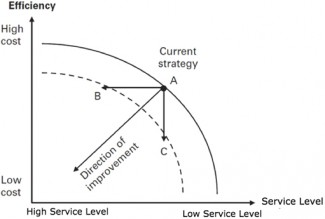By Nicole Bradick

Nicole Bradick
The field of operations management is focused on creating efficient and effective business operations. It recognizes that there are trade-offs that must be made between efficiency and service level (or other similar metrics) in any organization’s business and operations strategy. Companies, as a general rule, cannot be both highly efficient (low-cost), and offer high service levels.
When plotted on a graph, firms will typically fall along a curve that represents this trade-off. Some firms may choose to offer a very high level of service, which comes at a higher cost. Others may choose a lower service level at lower cost. In operations management, this curve is known as the “efficient frontier.” This is represented by the bold curve in the chart below.
This concept was developed in the supply chain management context, where the focus is on improving response time while reducing cost. The goal is always to keep making operational improvements so that the organization moves further toward the bottom left corner.

Law firms should be similarly focused. If a firm is more efficient in its operations, it can offer more competitive rates to its clients. The higher the service level (think a combination of expertise and talent of attorneys, responsiveness, outcomes, depth of attorney bench, complexity of work, etc.), the better served a firm’s clients will be.
Point A shows one firm’s strategy, which is to offer midlevel services as compared to competitors at midmarket cost. A firm might accomplish this by hiring less-expensive but less-pedigreed lawyers than their competitors, for example. Or perhaps the firm offers fewer lawyers, keeping its labor costs down, which necessarily reduces the options available to clients than the firm’s larger competitors.
When all firms lie along the same efficient frontier, they are all well-positioned to compete with each other based on their different market propositions (reflected in their strategic choices as to the trade-off between service and efficiency).
The dotted line, however, represents a shift in the efficient frontier. This is where things get tricky for firms who are left behind. The firm in our example may develop a strategy to move further to the bottom left. This might involve reducing costs through alternative staffing, adopting new technology, or developing better workflow and process. The operational improvement gained if the firm maintains the same service levels is represented in Point C.
Alternatively, the firm may choose to increase service levels by adding attorneys, increasing output, offering a wider range of solutions, and so on. If the firm can accomplish this without increasing cost, the firm will shift to Point B.
Once firms start moving to the new efficient frontier, the firms that are left behind in the old frontier may very well survive the shift (particularly if they have some significant competitive differentiation not reflected in cost versus service). But the gap that exists been the dotted curve and the bold curve represents inefficiency. There is considerable correlation between a firm’s customer value proposition and its operations strategy. When an inefficiency gap exists, it almost always represents a less attractive value proposition for clients of firms that are left behind. Consumers will eventually recognize the shift and will move to firms operating in the new frontier.
So where is the legal industry today? While most firms still remain along the old frontier, the frontier has indeed shifted. Alternative labor options, modern technology and modern business strategy have allowed new competitors to enter the market further to the bottom left than the existing firms. Lower-cost law firms are offering similar service levels as the traditional firms, but with greater operational efficiency (think lower overhead, more favorable partnership compensations schemes, leaner technology).
So what does this mean for firms sitting along the old curve? They have three options:
1. Maintain the status quo. There is nothing wrong with the old way if your firm is uniquely positioned so that your clients are still coming and are receiving value. For example, if you’re a firm in a rural location and competition is not an issue, you may not be running your firm in the most efficient manner, but you could very well run a happy business with happy clients and little harm to the profits you have been enjoying. But there will be a tremendous missed opportunity for that firm to increase profitability, acquire new clients, and serve new populations. For example, gains in operational efficiency can mean the ability to lower rates without harming margins, which could open up opportunities to serve lower-income clients.
2. Meet the rest of the gang in the new frontier. We see firms doing this every day, in part because clients are no longer interested in the service levels they had received for decades because they are no longer willing to tolerate the attendant costs. An example of this is a trend among large firms of establishing lower-cost contract attorney groups as a way to offer a broader range of services while keeping labor costs down. Firms that will thrive in the coming decade or so will be advancing to the new frontier. An important question to ask: What is the minimum level of service required to meet your clients’ needs, and what will they be willing to pay for that?
3. Create the next frontier. How do we shift the efficient frontier even further to the bottom left of the graph? Innovation. Most of the current shift in the frontier has resulted from redesigning process and reducing infrastructure and waste, all assisted by technology. The next frontier shift will more heavily involve technology and rethinking the way legal services are delivered. Technology will play a greater role in replacing some of the work of lawyers, thereby dramatically reducing cost, and perhaps even increasing service level. Over the next decade and beyond, we will see this shift begin to happen as more commoditized legal work (e.g., legal research, due diligence, basic contract formation) moves from being performed by lower-cost outside providers (which is prevalent in the existing efficient frontier), to being performed by computers.
Welcome, friends, to the next frontier.
Nicole Bradick is chief strategy officer at CuroLegal, a company that works with lawyers to launch and grow next-generation firms through its consulting services, operations support, and flexible staffing solutions. She was the founder and CEO of Custom Counsel, a nationwide network of freelance attorneys that was acquired by CuroLegal in 2015. Nicole has received recognition as an ABA Journal Legal Rebel and was named to the 2014 Fastcase 50 list.
Editor’s note: The New Normal is an ongoing discussion between Paul Lippe, the CEO of Legal OnRamp, Patrick Lamb, founding member of Valorem Law Group and their guests. New Normal contributors spend a lot of time thinking, writing and speaking about the changes occurring in the delivery of legal services. You’re invited to join their discussion.